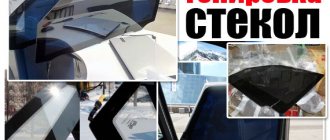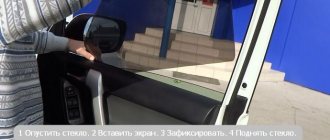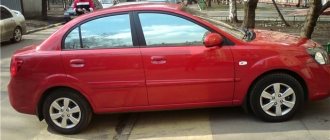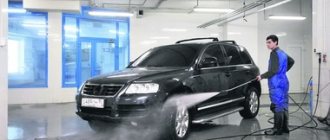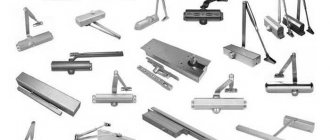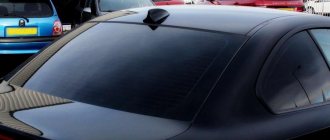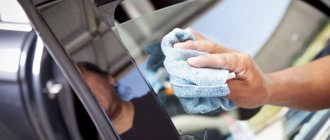Tinting
Author temass
Date
Jul 18, 2017
864
Share
Film for car window tinting is exactly what many motorists use today to begin external car tuning. This is not surprising, because such a modification not only makes the car’s exterior unique, but also makes driving more comfortable. On sunny days, the upholstery in the cabin does not fade, and the temperature always remains comfortable.
- Tint film device
- How to choose a tint?
- Popular types of film
- Other types
- Removable tint with plastic base
- Removable silicone tint
- Electronic SPD tinting - dear Americans
- Infinity – mirror films
- Chameleon
- Spray tinting
- Rating of the best tint film
- ZM – for windshields and front windows
- Armoland
- Solartek
- Nexfil
- SolarGard
- Global: price-quality
- Johnson - color film
- Sun Control
- SunTek
- LLumar
On many modern cars, tinting film is installed at the factory. But its darkening usually does not exceed 5-10%. For most motorists, this is simply not enough, so they ask the question: “How to choose a tint film?” Below we will present a rating of films, describe its types, and also give recommendations for selection. But before that, you need to figure out what the film is made from.
Types of protective materials for car windows.
film
Of course, in addition to compliance with state standards, there are several parameters for choosing film. As a rule, protective material is selected based on the goals of the car owner and the operating conditions of the car. Depending on the model and manufacturer, the film has different protective properties. If your car often takes part in competitions to overcome difficult sections of the road, you need to select a film with good resistance to mechanical damage. This way you will prolong the good condition of the glass surface. Today, there are films of increased safety that can withstand quite serious mechanical impacts.
Despite your own preferences, it is still important to choose a film that meets the necessary standards in order to avoid an unpleasant conversation with a traffic police officer
Types of films
Removing tinting from glass
Modern tinting films are divided into several groups, each of which has its own features and characteristics:
- Painted. The least durable film for tinting, so nowadays it is used less and less. A layer of paint is applied to the film, which wears out after a while. The only advantage of this option is the low price.
- Metallized. A film for cars coated with metal particles that give it a characteristic shine. This variety lasts a long time and protects the interior from sunlight.
- Spatternaya. Metal spraying is used, but it is applied differently. The durability of this product is such that manufacturers give it a lifetime warranty, which affects the price accordingly.
- Infiniti. Metal particles in the material give the surface a mirror shine. The law prohibits the use of materials with a mirror surface, so the driver has a chance to pay a fine for this type of tinting.
- Athermal. A film for cars that provides highly effective protection of the interior from heating under the influence of ultraviolet radiation. This is an excellent means of thermoregulation inside the car.
The chemical composition of tint films is different for different types of films and depends on the manufacturer, the quality of the films, their characteristics and main purpose.
- With the transition. The deposition of metallized particles gradually increases so that maximum protection against ultraviolet radiation is provided when the sun shines brightest and is at its zenith.
- Carbon tinting. It differs in that instead of metal particles, graphite is used for spraying. It has high performance characteristics, but its cost is higher than that of other materials.
- Removable film Sparks. Allows you to quickly remove the darkening and, if necessary, install it again. Considering that ordinary film is causing disagreements with the road inspectors, more and more motorists are using removable tinting on the forehead is prohibited, so some people use Sparks. When meeting with traffic police officers, it is simply removed by slightly prying it off the edge with a fingernail, and then reinstalled - this procedure is extremely simple.
Glass tinting materials are differentiated depending on the purpose of use. There are three groups:
- Decorative.
- Shockproof.
- UV protection.
In the event of an accident, the film will protect the driver and his passengers from glass fragments and, as a result, injuries.
Transmitted light standards
Car owners buy film to prevent sunlight from entering the interior. Therefore, its main indicator is the degree of transmitted light. From the inside, external visibility should be good, but if the tint is too dark, it gets worse. For safety reasons for passengers, drivers and pedestrians, it is important when choosing a material not to overdo it or buy the wrong type. When tinting a car, you should adhere to GOST. This way you will avoid unwanted problems with traffic police officers and fines. In accordance with GOST, the following standards of permissible light transmission in percent are established:
- Windshield - at least 75%. Externally, the tinting is invisible and protects well from sun glare.
- Front side windows - 70%.
- The rest of the glass is not standardized. If desired, you can tint it 100%.
- It is allowed to stick a dark-colored strip 14 cm wide at the top of the windshield, but no more.
The appropriate type of material is selected depending on the result you need. It is important to know that the darker the film, the lower its percentage of light transmission. The following types of tinting are used for rearview windows:
50% - Externally, the film looks like tinted glass, but everything inside the car is clearly visible. This is the lightest option and provides good protection from the sun.
- 20–35% - People who want to hide from prying eyes like to use this tint. From the outside, you can see the faces of the passengers in the cabin. It cannot be used on a windshield.
- 15% - The effect of one-way visibility is obtained. There is good visibility from the inside, but only silhouettes are visible from the outside.
- 10% - Barely noticeable outlines of people inside. You can also use lighter colors for sun protection.
- 5% - The darkest material is applied to the glass. It provides maximum protection for the interior from outside eyes, but in the evening the view through such glass becomes inconvenient.
Films with a light transmittance of 10–25% are especially popular among car owners.
Car tint film
Window tinting for VAZ 21099-2109-2108
Any color car tint film is a multilayer structure. The cheapest and most useless film, and it has at least two layers - an adhesive layer and a layer of colored film. We will not talk about bad films, about their harm to the eyes and the surface of the glass. A good film consists of a combination of transparent polyester, dyed polyester, metallized polyester, spattered polyester and, without fail, installation adhesive, the chemical composition of which is completely compatible with the composition of the film used. Therefore, car tint film can be:
- painted
- metallized
- spatter
- metallized spatter
We will not delve into the intricacies of chemistry, but will simply learn everything we need, as film carriers, about the layers and types of films. All major film manufacturers, SunGard, Llumar, Suntek, ASWF, BlackBox (American), supply film with installation adhesive, which has an additional water-soluble surface that facilitates installation of the film on glass. Now let's look at the types that we have listed.
Automotive films painted
The cheapest and simplest are dyed tint films.
The simplest and most inexpensive types of films without additional functions. They contain only a layer of polyester dyed using a special technology, and a layer of transparent polyester, which performs protective functions. In addition, such a film necessarily contains “anti-scrubbing” - a non-scratching layer, the absence of which immediately appears in horizontal stripes after the second opening of the window. The same installation adhesive protects the film from ultraviolet radiation and fading. The most affordable price per roll, this film will do the maximum to improve the appearance of the car.
Metallized auto films
Their range in Europe is simply incalculable. This is perhaps the most popular type of film there. The most fusible metal is aluminum. It is applied to polyester using the electron beam method. The metallized layer is laminated with dyed polyester, all covered with a scratch-resistant layer. As with painted films, installation adhesive protects the surface from UV rays. Metallized films effectively reflect the sun's rays, eliminating the issue of overheating of the interior, while the transparency of the film remains at the level of colored films. Externally, such films can be with transitions from one color to another, or they can be single-color.
Spatter auto films
Sputtring is metallization by ion exchange under inert gas conditions. The advantages of such films are a stable, uniform metallization coating, which eliminates visual distortions, high strength and density of the coating; the process allows you to apply any material to the film. While retaining all the properties of previous types, spatter films can last several times longer. Many manufacturers provide a lifetime guarantee for such film, installed under appropriate conditions and in compliance with the gluing technology. Spatter metallized films are a hybrid type and fully retain the characteristics of both films. They, perhaps, top the rating of the most effective films.
Athermal auto films
Athermal tint films have 100% light transmittance
The point of their use is that they prevent 90% of the penetration of ultraviolet and infrared rays into the cabin. Everything we wanted from color and mirror films - the best protection from the harmful effects of the sun, protection for the interior trim, dashboard, panels and covers, all this is offered by 3M athermal film. This is with full transparency of the film. Despite the 200 layers of which it consists, the film is barely noticeable on the glass. It can, indeed, be legally used to cover a windshield. But. Sales of counterfeit film are on the rise. Before you buy, ask for a certificate.
Rating of the TOP 7 best manufacturers of tinting film
Currently, there is a huge number of tint films, we have analyzed most brands, and prepared for you a rating of the best manufacturers:
Let's start with a detailed description
Llumar
It is one of the most expensive models on the trading platform. The presented film is produced at a large production facility in America. It has a significant degree of protection against burnout and has an increased operating period (4-5 years), during which its qualities remain consistently strong.
| Thickness | 0.0254 mm |
| Transmittance | 50% |
| Life time | 10 years |
pros
- good light transmittance (50%);
- long service life (10 years);
- excellent operating period (4-5 years);
- excellent quality.
Minuses
- Due to the large number of models, fakes are often found.
Price: from 20 to 900 rubles.
I thought for quite a long time whether to purchase this model or not. But I decided to stick it on my own car. I've been driving for more than six months now and haven't noticed any downsides. From the outside the car looks simply amazing. No matter who says it, you can clearly see from the cabin both at night and during the day. For those who are hesitant to buy the proposed model, I can only say to buy it with confidence. I recommend!
Armolan
By purchasing this model, you guarantee protection of your personal interior space in the car from solar radiation, as well as excellent throughput from inside the car. In addition to all this, a fairly long service life is noted, as a result of which the film has become quite popular on the market in Russia.
| Light transmission | 5% |
| Color | carbonic |
| Width | 152 cm |
| Length | 46.5 sq.m |
pros
- excellent quality;
- made in the USA;
- variety of colors;
- UV protection.
Minuses
Cost: from 400 to 700 rubles.
I have long wanted to purchase tinting for my personal car, because I’m already tired of driving as if in an aquarium, and many curious people passing by look into the interior of the car. I took the plunge and bought this model, tinted it, and it was great. The car’s appearance has simply been transformed 100 percent, everything from inside the car can be seen day and night, and finally, now you can’t see what’s in the cabin.
SUN GARD
Another film from an American manufacturer, which is in great demand among domestic buyers. When developing tinting, only the latest technological processes were used. Directly due to the unique developments, tinting has very high characteristics.
Kinds
How and which one to choose a memory card for a video recorder, smartphone, action camera. With Full HD, Super HD and 4K resolution
Let's now look at what types of glass tinting there are. Typically, tinting materials are classified according to the composition from which they are made. The tinting material determines its features. Considering which feature is more important, each car owner decides for himself which type of film is suitable for him. The most common:
- metallized tint film;
- mirror (infinity);
- film with a color transition from one to another;
- colored;
- carbon.
Metallized films
Metallic window tinting should be applied to best protect the car interior from fading and heating. Thanks to the finest aluminum coating, ultraviolet radiation is effectively reflected and the heating of the interior is reduced in hot summers. However, it should be remembered that such tinting transmits radio signals very poorly, so there may be problems with mobile communications.
Mirror films
Mirror film for glass is a type of metallized film. Its peculiarity is that the aluminized layer is not inside the film, but outside. Due to this, it reflects the sun's rays much better without compromising transparency, and is also stronger than conventional metallized film. So if the main purpose of tinting is to protect the interior, then it is better to choose this type.
Films with transition to another color
Not everyone will like glass tinting materials with a color transition from one to another. Such films consist of two parts: a metallized upper part and a colored lower part. The structure has a smooth transition from one part to another. From the inside, this window tint appears darker at the top and lighter at the bottom. The main purpose of tint films with color transition is car styling.
Color films
Colored glass film is the most common. It is made from several thin layers of different shades, layered on top of each other, resulting in a specific color. Affordable prices and a wide range of shades allow any car enthusiast to find his own color tinting option. But it is worth remembering that the low cost has a downside - these materials reflect the sun’s rays worse and wear out faster. Is it worth gluing such films, and what is the benefit of them? This is a big question.
Carbon film
The most high-tech to date is carbon film. It contains a microlayer of graphite sprayed in a vacuum. Innovative graphite technology provides carbon films with unrivaled performance. They perfectly reflect heat and sunlight, protect the car interior from fading better than others, do not interfere with radio signals, have a long service life and high strength. Gluing them is easy and simple. However, this type of tinting materials is not yet widespread, so the price is quite high.
Advantages
Car window tinting has many benefits:
- The car interior will retain its beauty for a long time, as tinting will protect it from fading in the sun.
- At night, the headlights will not blind the driver. The film absorbs light from the headlights of oncoming cars well.
- The car interior does not heat up in hot weather and does not cool down in winter, which saves fuel consumption and air conditioning life.
- During an accident, the people inside will be protected from glass fragments, as it will not shatter into small pieces.
- You can see everything from inside the car, but nothing from the outside.
- The suitable color of the film will make the car even more beautiful.
- This is good protection for your car from intruders. A broken window tint will cause them a lot of trouble.
It is also useful to read: What is electrical tinting for a car
Types of application technology
The first difference that different types of films have is the technology by which they are applied.
Removable toning
This type of product is most popular due to the ease of application of the material, as well as its low price.
People also call it American film. It can be purchased in a variety of colors, making it easy to install for any type of vehicle.
Similar coatings come in the following types:
- painted;
- metallized.
Additionally, removable types of tints are distinguished depending on the material used as a base:
- Plastic. Such a film is first applied to the base, and only then mounted on the glass using special tape.
- Silicone. It is installed on glass by forcing, for which a special chemical solution is used.
The positive aspects of removable options are:
- ease and possibility of self-installation;
- Ease of use;
- ease of removal.
The only downside is the short service life.
Video:
Electronic tinting
This type of tinting is the most expensive. Moreover, it is often called adjustable or smart tinting. Due to the fact that the cost of applying such a coating on glass costs 1.5 thousand dollars per square meter, it is not very popular today.
The positive properties of this type of coating include its full compliance with the current GOST. But it is impossible to apply such tinting yourself. This requires skill and special professional equipment.
Video:
Sputtering
Another way to darken car windows is spraying. This procedure is carried out only in specialized services. To do this, the glass is first washed, cleaned, and then placed in a vacuum chamber, in which special polymer materials are applied to it in a small layer.
However, due to the following disadvantages, this type of tinting is not very popular.
- If you need to remove the tinting, you will need to completely replace the glass.
- The installation process is quite complex, so professionals are hired to carry it out.
- During the cold season, cracks begin to form in the tinting, which is due to an uneven expansion coefficient.
- Spraying is often applied to the surface with increased unevenness, which leads to a violation of the required level of light transmission.
- Over time, glare forms on the glass, interfering with the driver’s vision while moving. In addition to the above application methods, it is possible to achieve various color effects when installing tint.
Types of tinting
removable toning
It is the most popular because of the ease of installation and the ability to do it yourself, without contacting a car service. A car enthusiast only needs cutting tools, a plastic base, some skills and basic knowledge. Tint film is produced by many manufacturers and sold in a variety of colors.
The range is quite wide and allows you to choose the film according to your preferences. Products differ in the type of base and type of color application.
There are two types of films based on the type of production:
- Metallized - metallic paints are applied to the surface.
- Dyed - pigment is added to the polymer.
The first ones do not fade in the sun, so they are more preferable.
types of tinting by base type
- Removable silicone based tint. This tinting can be done on the basis of silicone; the best products are American-made, which have proven themselves to be of good quality. Silicone-based films have three degrees of light transmission. They are attached to glass by forcing, using a special chemical solution.
- Removable tint on a plastic base. The film is applied to a plastic base, then attached to the front windows using special tape or professional fastening tools. This tint can be applied many times and can be removed as needed.
advantages of removable films
- Possibility of removal.
- Ease of use.
- Durability.
- Easy installation.
- High level of safety: the glass does not break upon impact, but remains glued to the film.
electronic tinting
It is the most expensive variety to date. It is also called smart tint or adjustable tint. It is rare due to its high cost. The smart method is based on a special electrochemical layer, which under certain lighting gives a “chameleon” effect. Performed only by professional tuners. The variable capacity meets GOST.
spraying
This is a fairly complex type of work; it is recommended to perform the procedure only in specialized services. Metals or polymers are applied in a thin layer to the glass, which is lowered into a vacuum chamber. The low prevalence of the variety is due to a large number of disadvantages:
- Labor-intensive installation that requires professionalism.
- Permanent tint. To remove it, you need to completely replace the glass.
- In winter, cracks appear on the rear windows as a result of the uneven expansion coefficient in the tinting.
- There is a possibility of glare on the glass that will interfere with your view.
- Spraying is not always applied evenly and with the required level of light transmission.
Removable toning
Today it is the most popular material for car tinting. It gained its popularity due to the possibility of quick and easy installation, which you can do yourself. If necessary, removable tinting can be quickly removed; the number of installations and removals is unlimited.
Removable tinting comes in plastic and silicone bases. Plastic-based car tinting is mounted on special guides, and silicone-based film should be glued like a regular one. The second type has the longest service life and quality, however, the first option is faster and easier to remove and then install again. The car owner will determine which base is best to choose.
The nuances of choosing what to cover the rear and front windows of a car
Having decided on your attitude to GOST and its standards, you can proceed directly to choosing an option for yourself. Please note that the glass itself does not transmit 100% of the light (usually 90-95%). Before installation, it is advisable to take a small piece of material and check the total light penetration rate with the device.
Let's start with the "state employees". If finances are very limited, then you can even look towards Chinese film. Just don’t glue it yourself - you’ll suffer, use the services of pasters (you can then demand that the defects be eliminated from them). If you are consciously prepared for a short service life and gradual loss of color, this may be your option.
Dyed films from “famous” manufacturers from the previous section are distinguished by better strength and ease of gluing than Chinese ones. You can choose a more expensive film and edit it yourself. For the same money you will get a better quality car product.
The next “level” includes all types of metallized films: color, gradient or simply black. In addition to changing the appearance, the “load” includes protection from ultraviolet rays and good wear resistance (you can count on 5–6 years). True, you will have to pay extra for these properties. Good craftsmen can apply almost any design to color film (at the same level as airbrushing). If you are willing to pay an extra +30% for a higher quality product, take a tint film made using spatter technology.
Don't forget that the rear windows of a car are still intended for something. Or at least get a panoramic rearview mirror
Athermal film is suitable for practitioners who decide to comply with the law. Transparency allows you to completely cover the windshield and front windows. A high-quality “athermal” retains up to 90% of heat from the sun’s rays. Many people note that after installation they began to turn on the air conditioning much less often. This is achieved through multi-layering (up to 20 layers, depending on the manufacturer). Each layer blocks a specific narrow spectrum of ultraviolet and infrared rays. Naturally, such complex technology leads to higher costs. This is an option for those who are willing to pay for their comfort (windshield from 3,000 rubles). “Chameleon” performs the same functions, only with a beautiful shimmer, so it costs twice as much.
Color and gradient films are suitable for tuning lovers. Usually in such cases the "invisible" properties do not have much meaning. The main thing is to choose the right color.
When choosing a film for tinting, the main criterion is price. If there is no certain amount, then the choice is limited. But for every thousand you put on top, you get additional properties. Decide how important they are to you, and the choice will become clear. If you don’t glue it yourself, then take an interest in the finished work or find reviews on the Internet about how they can ruin the best film.
Which manufacturer is the best?
When choosing a tint, you must first pay attention to whether it belongs to a particular brand. The dominance of Chinese counterfeits is forcing manufacturers to take drastic measures to protect their products. An example of this is the popular company LLumar . In this case, the set with the film is accompanied by a corresponding quality certificate confirming the authenticity of the presented product.
The presented type of tinting coating is durable and resistant to various mechanical influences. Tinting is applied using the electrochemical spraying method. With its help, you can produce high-quality car window tinting, while changing the saturation and shade of the film. This coating is guaranteed to last 3-4 years. In addition, all products presented by this company comply with GOSTs and regulatory standards, which eliminates all kinds of conflict situations on the part of law enforcement agencies.
Article on the topic: How to get out of a rut
The next brand is SunControl . The tint coatings of this brand are beyond doubt. This is confirmed by its international popularity and an extensive network of branches in more than 10 countries, including Russia. The materials used to make all types of SunControl films are characterized by increased strength and elasticity.
ASWT , better known as American Standard, is fully justified Although the cost of such film is an order of magnitude higher than all others, its quality is beyond doubt.
The materials used in the manufacture of all types of films effectively absorb ultraviolet radiation, which has the most beneficial effect on the driver’s health and the wear resistance of interior elements.
How to stick the film yourself
You can invite a specialist who will quickly and efficiently stick the film on the windows, or you can handle the task yourself.
To work with film, prepare the following tools:
- window cleaning scraper. Choose a tool with a rubberized edge;
- scraper for cleaning windows - with a sharp edge;
- sharp construction knife;
- spray;
- a wide rubber spatula to cover a large area of glass;
- a piece of microfiber or cotton towel (without lint);
- detergent - baby liquid soap or shampoo is suitable.
What you need to know when working with film:
- The room temperature should be no lower than five degrees and no higher than forty. If the indicators are not met, the glue will either take a very long time to dry, or, on the contrary, it will set quickly.
- The humidity in the room should be no more than eighty percent and no less than twenty.
- Use a spray bottle to spray water into the room to keep the air moist.
- The room should not be dusty, so wash the floors and remove dust from the furniture in advance.
First you need to prepare the surface - wash the glass with a mild detergent. Using a scraper, remove dust and dirt from all corners. If your window is wooden, then the glazing beads can be removed and cleaned.
Now you can proceed to an equally important moment - cutting out the material. Take measurements and think about how you will cut the film. You shouldn't end up with a lot of waste. If the width of the film is not enough to immediately cover the entire surface of the glass, then think about where the joint will be located. When cutting, leave allowances for the material - from two to three millimeters.
How to install film on a window:
- Moisten the glass with purified water.
- Take some soap or shampoo and treat the surface.
- Place the workpiece on the floor or table and carefully remove the protective layer. During this time, you should constantly spray the film with water from a spray bottle.
- Make sure that the film does not stick together, otherwise it will have to be thrown away.
- Place the film on the glass, holding the ends. Please note that the glass and protective material must be well moistened.
- Fix the film at the top points and check its position. If you see a distortion, it is not too late to correct everything, because there is water under the film.
- Using a spatula, gradually displace the water from underneath the surface.
- Leave it to dry completely. This will take you one to two weeks. During this time, the darker film will gradually acquire a lighter shade.
- If air bubbles appear, you do not need to do anything - when the film dries, they will disappear.
- To prevent the spatula from leaving scratches on the surface, try to moisten it.
It is easy to care for tinted glass - they need to be wiped with a soft cloth soaked in soapy water. Do not wash windows with brushes or abrasives, as they may leave scratches on the surface.
Rules and process of tinting
Doing tint yourself is not difficult. But if you are doing this for the first time, you should watch a video tutorial on the Internet to have a general idea of the progress of the work. Or ask for help from people you know who have already done this. For gluing you will need: film and a spatula (sold as a set), a blade or stationery knife, a hair dryer, warm water, soap, a spray bottle, and glass cleaner. When all the parts are prepared, let's start gluing:
- First of all, thoroughly wash the car. Glass seals are removed from the doors. After this, the glass is cleaned and treated with a special solution.
- The glass is sprayed with a soap solution from the outside. Then they adjust the film and cut out the desired size, leaving a few centimeters in reserve.
- The protective layer is separated from the finished material. To neutralize the adhesive layer for 10 minutes, the side with the adhesive is sprayed with a soap solution. Similarly, the same solution is sprayed on the inside of the glass.
- We put film on top. It can be moved along the glass until the soap solution dries.
- All irregularities and soap residues are removed with a spatula.
- Then the glass is wiped with dry wipes.
- Stepping back 2 mm from the edge, cut off the excess film. This will help avoid peeling off in the corners over time.
- It is dried using an industrial hair dryer. The car should not be used for several days.
It is also useful to read: How to properly tint a car windshield
Rules for gluing tint film:
- During drying, the glass may burst if it has microcracks.
- Glass tinting is carried out only on the inside.
- The old film is removed entirely. It is enough to pry its edge.
- A special scraper will help remove the adhesive layer remaining from the old material.
- In order for the glue to completely dry and the film to finally adhere to the glass, it is not recommended to wash the glass from the inside or lower it for seven days.
How to choose a tint film
Percentage of light transmission.
First of all, you need to understand the light transmittance of the tint.
- If the percentage of light transmission is no more than 5, then the interior interior cannot be seen from the street. The use of such a film allows you to visually isolate yourself from the outside world.
- With 15 percent light transmission, passers-by will only see the silhouettes of passengers. But people from the street will not be able to distinguish their faces, as well as determine the type of objects.
- Starting from 35% light transmission, the faces of people and objects lying in the car are clearly visible.
- Such films can only be installed on the rear windows of the car.
Types of tint films.
There are several types of film materials that are used for tinting car windows.
- Dyed films are considered the most affordable and simplest. During the production process, the dye is introduced into the polymer base, creating a shading effect. The service life of such tinting is short, because the paint fades quickly.
- Metallized film materials have greater durability. Typically, an aluminum-based coating is applied to the paint layer. But such tinting creates radio interference.
- The energy-saving film appears transparent, but it effectively fights glare and UV rays, preventing them from entering the interior. With the help of such tinting, it is possible to save fuel by turning on the air conditioner at lower power.
- Carbon film is a modern and expensive material. Thanks to a special technology, a layer of graphite is applied to the film, which blocks the sun's rays. The product combines the best properties of all other types of tinting, but the price deters many motorists.
Film color
. Manufacturers use several color solutions when creating tint film.
- The metallic coating gives a mirror-like shine to the tinting on the street side. It reflects a large percentage of sunlight, but at night, visibility deteriorates.
- You can choose any color to match the body color, from black to yellow. However, according to experts, any color shade in tinting leads to rapid eye fatigue.
- Some car enthusiasts prefer a combined tinting option. The front windows (windshield and side) are shaded with a light film in accordance with traffic regulations. And dark tinting is glued to the rear windows; it creates a shady area in the car with a comfortable microclimate.
We have selected 11 of the best tint film manufacturers for review. All of them sell their products on the Russian market. When allocating seats, the opinion of the expert community and feedback from car enthusiasts were taken into account.
Film color
Currently, manufacturers offer a wide range of color films from yellow, red, green to dark brown. They can be combined, matte or metallized. Any car decorated with them will look like an exclusive one.
- The metallized material creates a special mirror-like shine and will look good on a metallic-colored car.
- Transition tint film is suitable for green, yellow, blue and bright red cars. Here the color strip smoothly turns into black.
- The combined option meets the requirements of traffic regulations. These are films from the same series: dark and light tones. Dark is applied to the rear windows, and light to the front.
Types of tinting. Which one to choose
Tinting film is a special multilayer “sandwich”, which is based on a special polymer base of minimal thickness. Various materials are applied to it, each of which is designed to solve specific problems - reducing light transmittance, reflecting sunlight, anti-abrasive coating. For reliable fixation on the car glass, a special adhesive backing is used.
All tint films can be divided into main types:
Dyed non-metallized films
The most budget-friendly tinting option that performs a purely decorative function. Darkening is carried out by applying special paint directly to the polymer base and does not require the presence of metallizing and protective layers.
Advantages
- Suitable for tinting glass;
- Inexpensive;
- Wide range of colors and percentage of light transmittance;
- There is no protection from sunlight and ultraviolet radiation;
- They fade in the sun;
- Minimal resistance to abrasive influences;
Metallized films
A more advanced type of tinting, consisting of three main layers - a polymer base, a metallized substrate and an outer protective layer. Aesthetic appearance, UV protection, good resistance to abrasive influences, as well as ease of operation - these are its main advantages.
Advantages
- Variety of colors and light transmittance values;
- Scratch resistance;
- Cool metallic shade;
- Protection from ultraviolet and sun rays;
- More expensive than non-metallized analogues;
- Block radio waves;
- Application to glass requires certain skills;
Infinity films
A type of metallic tinting, differing in the structure of layers. The metal layer in them is not placed on the substrate, but directly on the surface itself, which is why, when applied to glass, the film provides a mirror effect.
Advantages
- Light transmittance up to 80-90%;
- Abrasion resistance;
- UV protection;
- Wide range of shades and thickness options;
- Prohibited by law
;
- Require special care;
- Quite expensive;
Athermal films
Metallized models coated with a special compound that completely reflects the sun's rays. As a result, the car interior is not prone to heating up in the summer heat and does not cool down so quickly in winter.
